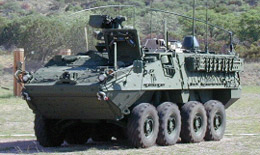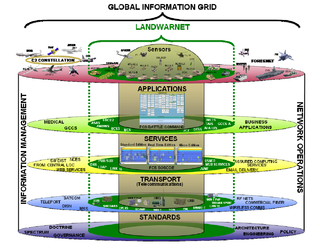In modern use, the order of battle of an armed force participating in a military operation or campaign shows the hierarchical organization, command structure, strength, disposition of personnel, and equipment of units and formations of the armed force. Various abbreviations are in use, including OOB, O/B, or OB, while ORBAT remains the most common in the United Kingdom. An order of battle is distinct from a table of organisation, which is the intended composition of a given unit or formation according to the military doctrine of its armed force. Historically, an order of battle was the order in which troops were positioned relative to the position of the army commander or the chronological order in which ships were deployed in naval situations.

Civil-Military Cooperation (CIMIC) involves military commanders establishing connections with civilian agencies in operational theaters.
NATO Joint Military Symbology is the NATO standard for military map symbols. Originally published in 1986 as Allied Procedural Publication 6 (APP-6), NATO Military Symbols for Land Based Systems, the standard has evolved over the years and is currently in its fifth version (APP-6D). The symbols are designed to enhance NATO's joint interoperability by providing a standard set of common symbols. APP-6 constituted a single system of joint military symbology for land, air, space and sea-based formations and units, which can be displayed for either automated map display systems or for manual map marking. It covers all of the joint services and can be used by them.
Mission-type tactics is a method of command and delegation where the military commander gives subordinate leaders a clearly-defined objective, high-level details such as a timeframe, and the forces needed to accomplish that objective. The subordinate leaders are given the planning initiative and freedom of execution: they decide on the methods to achieve the objective independently. This allows a high degree of flexibility at the operational and tactical levels of command, which allows for faster decision-making on the ground and frees the higher leadership from managing the tactical details to concentrate on the strategic picture. This may be contrasted with "Befehlstaktik" or command-type tactics.
The Army Battle Command System (ABCS) is a digital Command, Control, Communications, Computers and Intelligence (C4I) system for the US Army. It includes a mix of fixed/semi-fixed and mobile networks. It is also designed for interoperability with US and Coalition C4I systems.
The five paragraph order or five paragraph field order is a style of organizing information about a military situation for a unit in the field. It is an element of Canadian Army, United States Army, United States Marine Corps and United States Navy Seabees small unit tactics, and similar order styles are used by military groups around the world. An order specifies the instruction to a unit in a structured format that makes it easy to find each specific requirement. The five paragraphs can be remembered with the acronym SMEAC: "S" Situation, "M" Mission, "E" Execution, "A" Administration/Logistics, "C" Command/Signal.
Global Command and Control System (GCCS) is the United States' armed forces DoD joint command and control (C2) system used to provide accurate, complete, and timely information for the operational chain of command for U.S. armed forces. "GCCS" is most often used to refer to the computer system, but actually consists of hardware, software, common procedures, appropriation, and numerous applications and interfaces that make up an "operational architecture" that provides worldwide connectivity with all levels of command. GCCS incorporates systems that provide situational awareness, support for intelligence, force planning, readiness assessment, and deployment applications that battlefield commanders require to effectively plan and execute joint military operations.
Battlespace or battle-space is a term used to signify a military strategy which integrates multiple armed forces for the military theatre of operations, including air, information, land, sea, cyber and outer space to achieve military goals. It includes the environment, timeframe and other factors, and conditions that must be understood to successfully apply combat power, protect the force, or complete the mission. This includes enemy and friendly armed forces, infrastructure, weather, terrain, and the electromagnetic spectrum within the operational areas and areas of interest.

The M1130 commander vehicle (CV) is an armored command vehicle based on the Stryker platform. It is used within the brigade to provide means to receive information, analyze and transmit data, and control forces carrying out combat missions. Models with the double V-hull upgrade are known as the M1255 CVV.

Blue force tracking is a United States military term for a GPS-enabled capability that provides military commanders and forces with location information about friendly military forces. In NATO military symbology, blue typically denotes friendly forces. The capability provides a common picture of the location of friendly forces and therefore is referred to as the blue force tracker. When all capitalized, the term refers to a specific defense contractors' system, but the capability is found in many military and civilian mobile apps.
Sustainment Brigades were created as part of the early 21st century transformation of the United States Army from a division-based structure to a brigade-based army.
LandWarNet (LWN) is the United States Army’s contribution to the Global Information Grid (GIG) that consists of all globally interconnected, end-to-end set of Army information capabilities, associated processes, and personnel for collecting, processing, storing, disseminating, and managing information on demand supporting warfighters, policy makers, and support personnel. It includes all Army and leveraged Department of Defense (DOD)/Joint communications and computing systems and services, software, data security services, and other associated services. LandWarNet exists to enable the warfighter through Mission Command, previously described as Battle Command. Other U.S. service equivalent efforts to LandWarNet include the Navy's "FORCEnet" and the Air Force's "C2 Constellation."

The FCS Network - Brigade Combat Team (BCT) Network consists of five layers that deliver data to forward-deployed Army units.

Document Exploitation (DOCEX) is a set of military intelligence procedures used by the United States Armed Forces to discover, categorize, and use documents seized in combat operations. It is similar to, but otherwise separate from, Document and Media Exploitation (DOMEX), which is used by the U.S. Intelligence Community and the U.S. government.
Within military operations, a local operational picture (LOP) is a single identical display of relevant (operational) information of the battlespace constructed for local use.

Battle command (BC) is the discipline of visualizing, describing, directing, and leading forces in operations against a hostile, thinking, and adaptive enemy. Battle command applies leadership to translate decision into actions, by synchronizing forces and warfighting functions in time, space, and purpose, to accomplish missions. Battle command refers both to processes triggered by commanders and executed by soldiers and to the system of systems (SoS) that directly enables those processes.

PM WIN-T is a component of Program Executive Office Command, Control and Communications-Tactical in the United States Army. PM WIN-T has been absorbed into PM Tactical Networks as Product Manager for Mission Networks.

The BCT network is a layered system of interconnected computers and software, radios, and sensors within the Brigade Combat Team (BCT) designed to increase survivability and strategy on a battlefield where units can communicate internally instead of through a central command. The BCT Network allows for a more efficient use of communication and a possibility to plug combined-arms warfare into the network for better communication.
For military strategy, intent is the desired outcome of a military operation. It is a key concept in 21st century military operations and is a vital element to facilitate subordinates' initiative and collaboration and cooperation amongst team members in joint operations.







